Today@Sam Article
Nursing Students Travel To Nicaragua To Help The Community
June 28, 2017
SHSU Media Contact: Lane Fortenberry
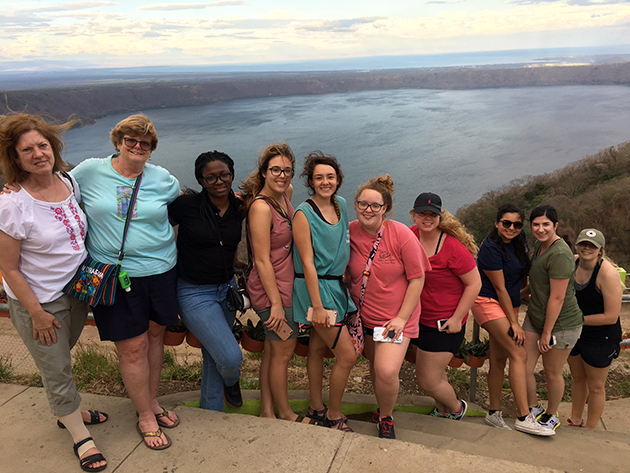 |
| Dianne Langton (left), Anne Stiles, Mo Adaboy, Payton Standley, Jessica Dominguez, Morgan Wiehe, Paige Henderson, Roxana Salazar, Natalie Mouton, and McKaylie Phillips visited Lake Nicaragua during the trip. |
Traveling to a new country can be an eye-opening experience. While it can provide unbelievable memories and fond stories, it can also reveal the harsh reality of the conditions others have to face on a daily basis.
Anne Stiles, professor in the School of Nursing at Sam Houston State University, Diane Langton, clinical associate professor, and David Standlee, member of the Huntsville Rotary, traveled to Nicaragua in March with eight nursing students to experience their hospital, schools, university, culture and water wells.
The students were McKaylie Phillips, Paige Henderson, Natalie Mouton, Roxana Salazar, Jessica Dominguez, Mo Adaboy, Morgan Wiehe, and Payton Standley.
During the time they spent at the hospital of León, students experienced conditions far different than the ones in the United States. They were split into pairs and rotated throughout pediatrics, the Neonatal Intensive Care Unit, labor and delivery, and the postpartum unit.
“That was unique for them because the hospital in Nicaragua is just—horrible,” Stiles said. “It’s like what our bad hospitals used to be in the ‘50s. No computers, blood on the floor, and the elevator had a crack from an earthquake that happened nearby. You could smell sewage in the city.
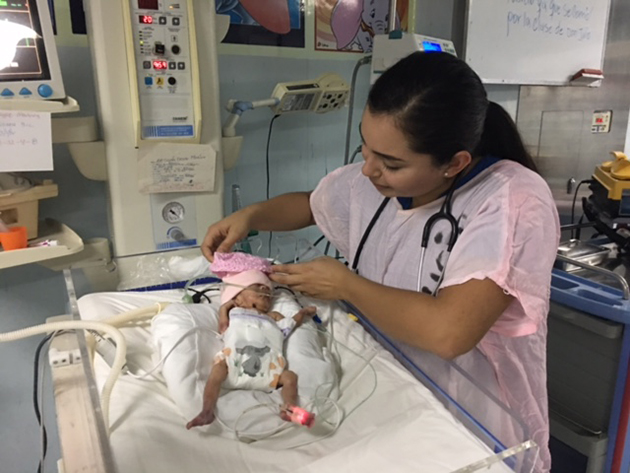 |
| Salazar cares for a newborn at the Neonatal Intensive Care Unit at the hospital of León. |
“They don’t wear gloves for anything, except maybe surgeries, but we wear gloves for everything,” she said. “Just, really antiquated machinery, equipment and all. It’s just awful. The students get a good exposure to conditions that are so different from America, and it really makes them appreciate what we have and humbles them.”
Numerous windows in the hospital were broken or missing, which created harsh conditions for the patients and employees.
“There were literally pigeons walking around the hospital floor—and that’s not too sanitary,” Stiles said. “They had no air conditioning and it was 90 or 95 degrees there in March and pretty muggy. Everything was done by hand. I can’t even imagine how many mistakes were made in that hospital.”
A lack of proper equipment and personnel caused a few problems during their two days at the hospital.
In one instance, a baby in the pediatrics unit started choking.
“Our student was looking around for suction, which is something we have beside every bed here,” Stiles said. “She couldn’t find any. She asked the nurses where the suction was, and she said they didn’t have any. She asked about oxygen, and they didn’t have any. She asked for a bulb syringe, and they didn’t have those.
“They told her to basically pat the baby on the back, and that’s all she could do,” she said. “That’s so sad. Next time we go down, we’re going to try to bring bulb syringes, oxygen and anything else we can get.”
Salazar helped a 16-year-old mother with her newborn baby, which is one of her favorite memories of the trip.
“When I first came in to visit with her, it was evident that she was really struggling with her baby,” she said. “The baby would not stop crying, and she seemed frustrated and tired. At the same time, she seemed lost and didn’t know how to take care of the baby. I asked the mother if I could hold her baby and she immediately said yes.
“A few minutes later, I was showing her how to swaddle the baby and giving her some tips on ways to make the baby feel more comfortable,” she said. “In no time, the baby went to sleep. I could see it in the young girl’s face that she was really happy because the baby had stopped crying. She thanked me for helping her.”
The experiences at the hospital were life-changing for Salazar.
“I was able to see the difference between the hospitals here and the hospitals in Nicaragua,” she said. “After seeing the environment and the low amount of resources in the hospitals in Nicaragua, I was able to appreciate what we have back home. The hospital had a lot of patients but not enough room. In the pediatric unit, there were about 15 kids in one of the rooms and when one of the kids would cry due to pain, it would affect the rest of the kids.”
Because Salazar grew up in a Hispanic culture, she found it easy to relate and communicate with the people of Nicaragua.
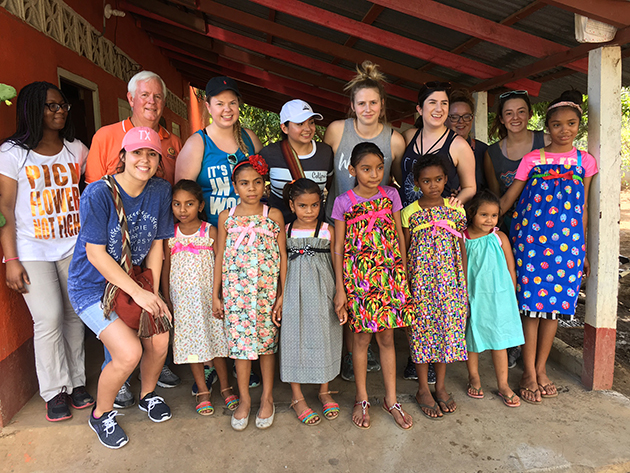 |
| The group donated dresses to the children at Cheryl's Place, who quickly put them on over the clothes they were wearing. |
“The people were very friendly, open, respectful and welcoming,” she said. “Usually, I was the one that had to start the conversation because I think they felt intimidated by someone new, but as soon as I began to ask questions, they were very attentive to me.”
The group spent a day going to a place they call “Cheryl’s Place,” an informal orphanage founded by Cheryl Spence, an American woman who traveled there around 15 years ago based on a calling she had to raise children in need.
“There are lots of children there that they call the ‘throw away children,’ because they have some sort of physical or mental deformity and the parents either can’t afford them or don’t want them,” Stiles said. “So, they drop them off at Cheryl’s Place. She takes them in like foster kids and raises them as if they’re her own.
“She has 15 kids living with her,” she said. “They come all the way from infants to 18-years old. They may have a cleft palette or lip, seizures, or one young boy had hip dysplasia that he had at birth. It’s such an easy thing to correct here; a simple surgery will do it and it’s done as an infant. He didn’t have the surgery because they couldn’t afford it, so he can’t walk at all. It’s just so sad.”
Salazar said the people from the poor villages were more reserved and hesitant to approach the group.
“The children from these areas were probably the happiest children I have ever seen, though,” she said. “As soon as they saw us, they would walk up to us, waiting to see what we brought. They were easy to play with and full of smiles and laughter. They looked happy playing outside—with no technology.”
The Huntsville Church of Christ’s women’s group, along with some of the nursing students and Stiles, made gifts to send to Nicaragua.
“We took down tons of gifts for them,” Stiles said. “The church made 20 dresses and blankets. Some of our nursing students made blankets, too. We took diapers, games, medical supplies and all kind of things. I crocheted some caps for the NICU babies. We had six big suitcases full of things, plus cash that the church had donated. Most of it went to Cheryl’s Place and some of it went to some schools.
“They were all smiles and really, really happy,” she said. “They hugged us and just loved it. The little girls put the dresses on right over their shorts. They have a trampoline in their yard so they went and jumped with their dresses on. They even sang us a song.”
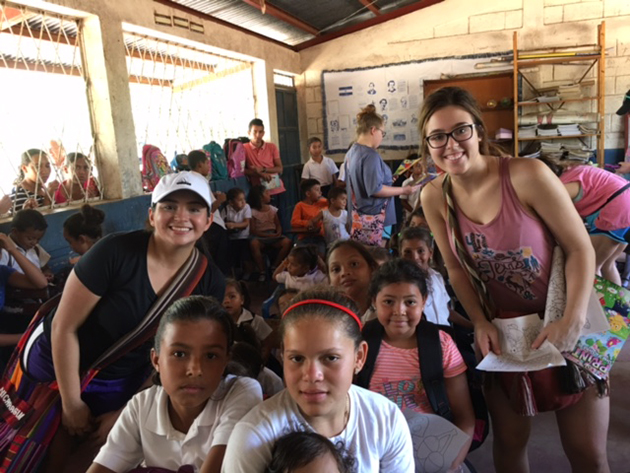 |
| Salazar (left) and Standley inside one of the rural schools the group visited. |
Part of the trip was devoted to visiting the water wells as part of the initiative to visit Nicaragua. Standlee and Stiles, who is also a Rotarian, worked with the Rotary in the area to help set up the trip. The Huntsville Rotary has drilled around 300 water wells in the rural communities.
“Part of Huntsville’s Rotary projects are drilling wells in Nicaragua for rural areas where they wouldn’t have water, or else they would have to drink straight out of the river,” Stiles said. “Nicaragua is the second poorest country in Latin America, and because of that, people weren’t getting clean water for drinking. There are far more requests than we can meet.
“We visited those wells to make sure they were still working and to see the people,” she said. “These folks live incredibly poor lives. They live in tar-paper and tin shacks with one room for the whole family. They do their laundry either in the river, or they go in the morning and fill up 10-gallon buckets from the wells we drill and take it back.”
Some families have to walk several miles to get to the nearest water well for clean water.
“Roads are made out of dirt and the children run around without shoes,” Salazar said. “The trip was very eye-opening and being able to experience that kind of poverty face-to-face is much different than hearing about it. It’s something truly amazing to be able to help these people, even if it’s with a simple pair of sandals. Something so minimum can make a difference in the lives of these people.”
Ever since she was in high school, Salazar has dreamed about studying abroad in college, especially in poor countries where she knew she would be able to help other people.
“I’m a person that loves helping others, which is why I wanted to become a nurse, exploring new things and meeting new people,” she said. “As soon as I heard about this trip, I wanted to go. I was thrilled because I knew I was going to be able to communicate very well with the people since I can speak Spanish fluently.”
Salazar said she loved so many parts of the trip, it makes it hard to choose her favorite moment.
“I’m very thankful for having the opportunity to go on this,” she said. “I loved the experience at the hospital because I learned so much. I also liked visiting the poor villages and schools because we had the opportunity to make other children smile by bringing them simple things. I had a great time visiting the volcanoes, different towns, islets and restaurants.
“But, one of my favorite parts of the trip was the night we went to dinner at the home of one the Rotarians from Nicaragua,” she said. “We had a great time and were able to share fun moments. We had a good time with the people, despite our different cultures, and that is what I value so much—being able share laughter and joy with other people even if we have our differences.”
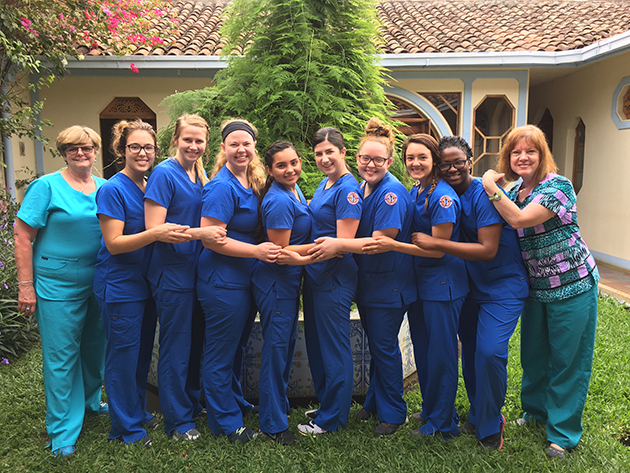 |
| The group was invited for breakfast by Angeles Bermudez, founder of the district Rotary. |
- END -
This page maintained by SHSU's Communications Office:
Director of Content Communications: Emily Binetti
Communications Manager: Mikah Boyd
Telephone: 936.294.1837
Communications Specialist: Campbell Atkins
Telephone: 936.294.2638
Please send comments, corrections, news tips to Today@Sam.edu
